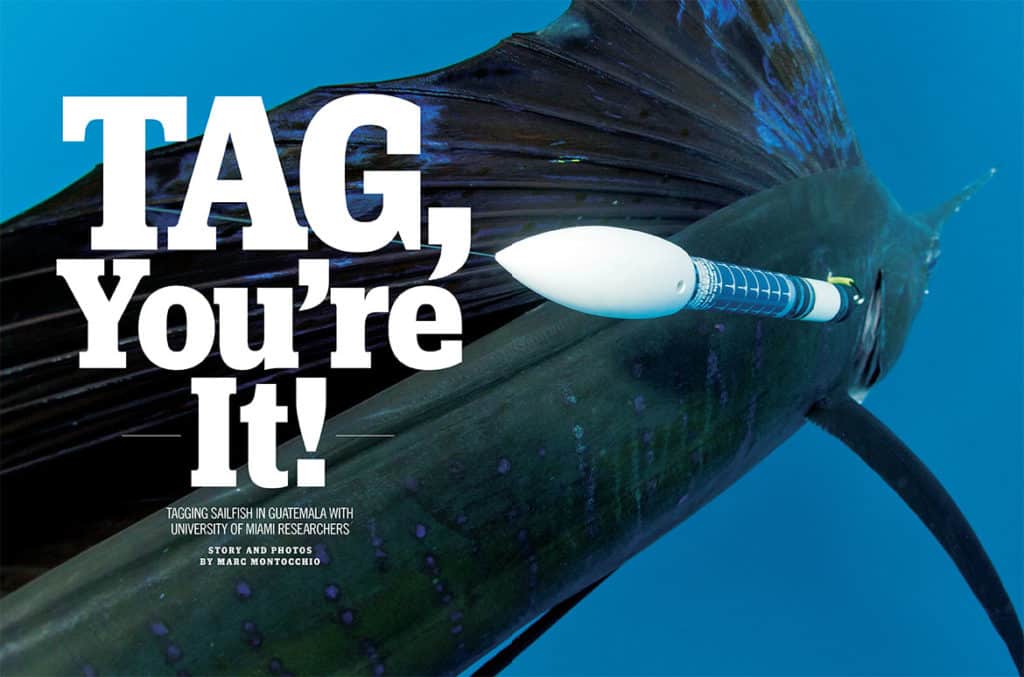

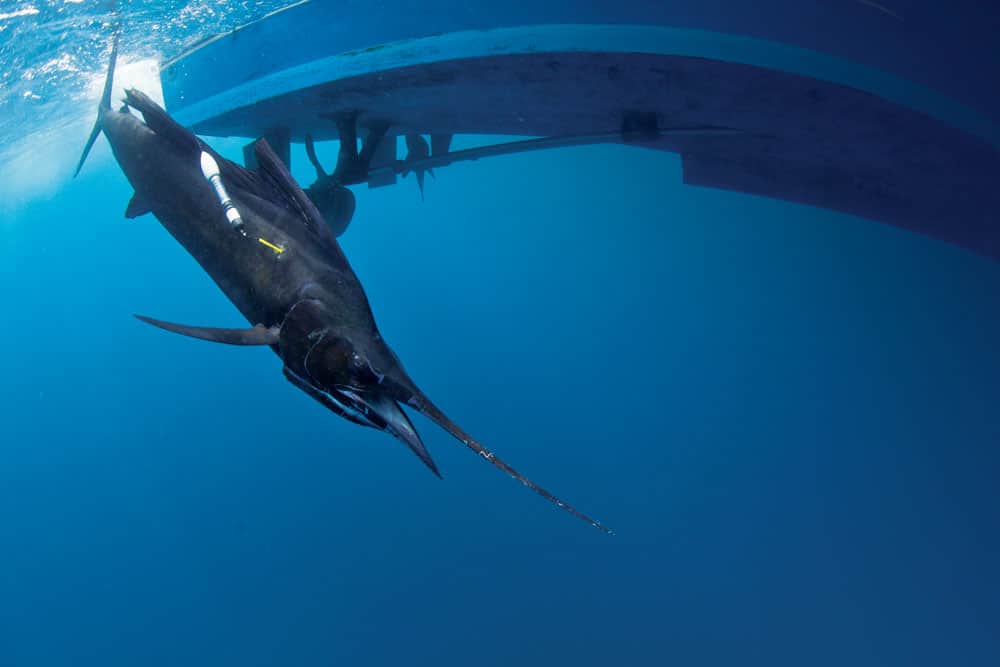

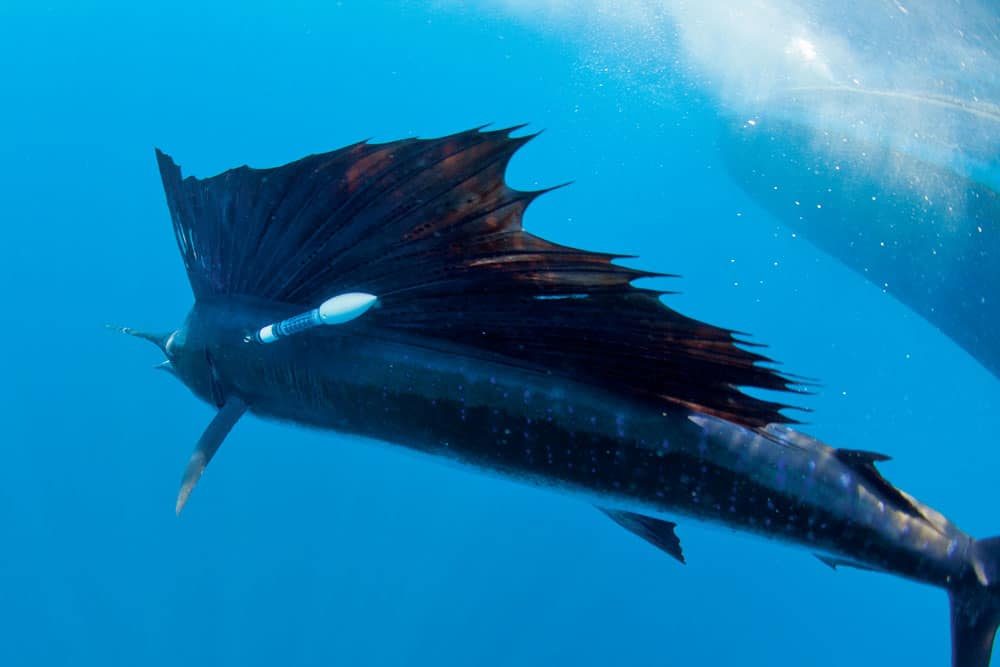

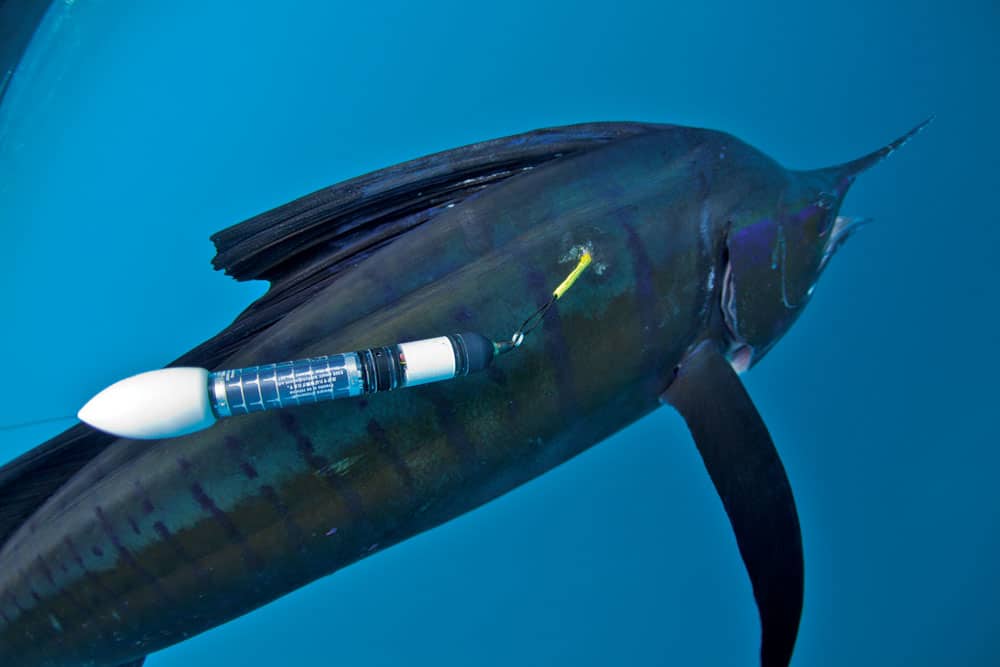



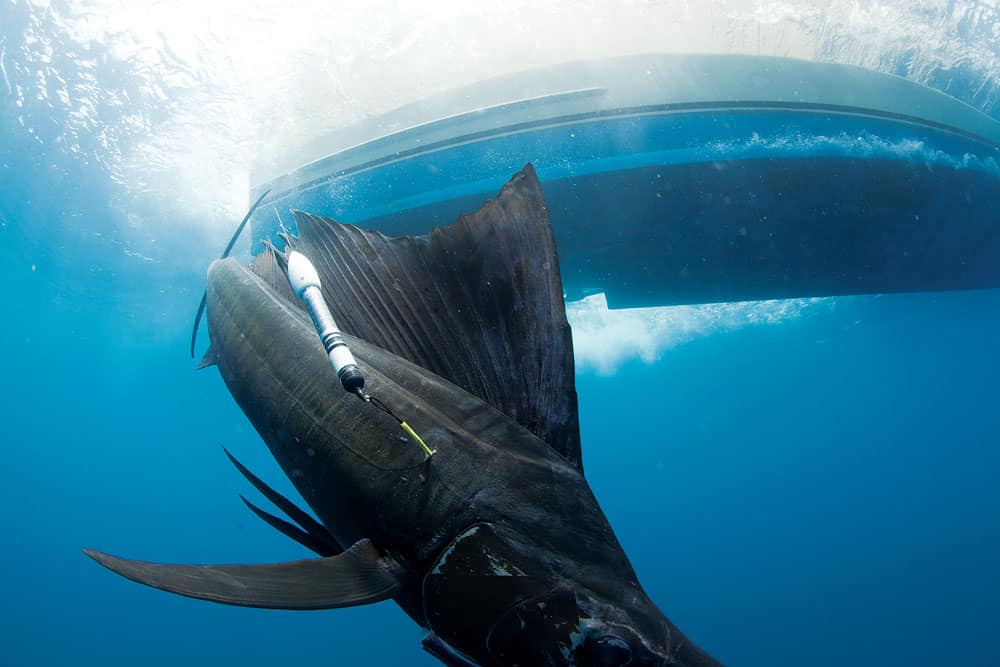
(To see the full tagging adventure, click through all the photos in the gallery above.)
Most people would be surprised to learn how little is known about billfish. For example, how fast can they swim? There are some wild numbers thrown around, mostly based on anecdotal information, estimates and convoluted calculations rooted in sometimes very weak so-called science. Consult Google and you will find that most people believe sailfish are the fastest of the billfish, but there are some who disagree. The real question is, how fast are they really? When an opportunity to find out arose, I seized it.
The whole adventure began when I met Mark Fitchett, a marine biologist working on his Ph.D. at the Rosenstiel School of Marine and Atmospheric Science at the University of Miami. I met with Fitchett, his professor Nelson Ehrhardt and another Ph.D. student, Bruce Pohlot. We instantly bonded over animated and passionate discussions regarding the life and behaviors of billfish, my point of view coming from my experience behind the camera and theirs from scientific study of billfish behavior and data — lots of data. As part of Fitchett’s and Pohlot’s doctoral dissertations, they were about to deploy a series of pop-up satellite tags (PSATs). Fitchett was interested in the oceanography and population dynamics of sailfish in the ecosystem, and Pohlot’s research centered on measuring short-term behaviors in sailfish. Pohlot intended to get a look at a thin, yet highly detailed, segment of a sailfish’s life using revolutionary short-term high-resolution PSATs. This method differs from the more wide-view approach that uses the longer-term satellite tags common in marine pelagic research today.
Off to the Field
After several months of emails and phone calls, I received an invitation to join the pair in the field or, more accurately, in the sailfish-rich waters off the Pacific coast of Guatemala. I landed in Guatemala City and was met by the Casa Vieja Lodge’s driver, who whisked me away post-customs with incredible efficiency.
As the giant doors of Casa Vieja opened, we were suddenly transported to a faraway place. Inside the Spanish-style courtyard, there was perfect calm. A sailfish fountain babbled in the background as I was welcomed by a row of smiling faces and handed a refreshing margarita. Late-afternoon sun bathed the bar’s wooden interior in an ethereal yellow glow, stretching long, lazy shadows across the floor and sparkling off its shiny varnish. Looking up at the wooden-beamed ceiling, I was made very aware of the pedigree of Casa Vieja Lodge and, by extension, the sail fishery in this part of the world. On display were photos and memorabilia from some of sport fishing’s greatest names. The building is a veritable shrine to the pursuit of sailfish, specifically on fly. The same thing that drew me — a constant, abundant supply of large Pacific sailfish — had drawn the scientists, and they would try to gain insight about these fish, using specially designed PSAT tags.
We were all up early the next morning, and I soon found Fitchett and Pohlot preparing the satellite tags on a small patch of grass near the office. They brought 20 tags in total, each costing almost $4,000. With a receiver and laptop, Fitchett confirmed that each tag was working as he communicated with the Argos satellite whizzing past miles overhead. The duo had spent the previous night mixing the explosive material that formed the link between the anchor and the business end of each tag. When triggered on a specific date, this link would separate the tag from the test fish. If all goes well, the tag pops up to the ocean’s surface, makes contact with the Argos satellite and uploads its precious data package. The University of Miami’s computers would then download the data, which are then interpolated and analyzed by the group, and turned into data for peer review. Eventually the data are used to develop strategies to help preserve and protect these fish. But before any of this can happen, the scientists had to catch the sails and insert the tags in the fish, via a surgical steel anchor, under their skin. The tricky part is doing this without fighting the fish to the point of no return.
Teamwork
There were several projects set to go on as part of the study, with both scientists working together. Some of the tags were going to record information over longer periods, ranging from a few months to a year. The long-term tags were part of Fitchett’s research interested in the big-picture data, like sailfish distribution and habitat and how that changes in this part of the ocean. Pohlot, a Yale graduate with a biomedical background, was working on the behavior I was most interested in. The short-term high-resolution data tags would pop off in just 10 days, capturing a more intensely data-rich look at a fish’s life post-release, including what was, for me, the holy grail of stats: the speed and acceleration of the fish.
It was only a couple of miles from the lodge to the port and only a few yards down the dock to our ride for the next few days, Captain Hook. Our captain, Ronnie Hamlin, was a legend in Central American sport fishing. If there were ever a fishing version made of the Pirates of the Caribbean movie, Hamlin would be at home on Black Pearl, among the crusty old salts. He looks like a cross between Johnny Depp and Keith Richards, and Hamlin has forgotten more about catching billfish in this part of the world than most of us will ever learn in the first place. Our charter was to be one of his last before retiring to Florida. Mates Hector and Sammy rounded out the crew, along with the three scientists, me and a bucket full of loaded tags.
I’m not sure if the weather is always like this, but the sea conditions in Guatemala were incredible that day — completely slick calm. After about an hour’s ride out, we put the lines in the water and got to work.
The UM team spent a lot of time refining and designing the hardware it used to tag the fish. Some of the planning was to prevent long-term injury to the fish. The tags sport white bulbous heads made of high-density foam that provide the pop-up mechanism. On the top, the foam tapers into a cone shape and eventually into the short, black whip antennas designed to communicate the data to the satellite. The cylindrical bodies are covered in a checkerboard pattern made of solar-powered photo-galvanic cells that recharge the internal battery when the tag is on or near the surface. The base of the tags narrow sharply into the breakaway explosive link, before attaching to a section of coated stainless-steel cable and the surgical steel blade that anchors the device. The blade was designed to enter the fish’s muscle on its back, turn sideways and secure itself in the tissue. During deployment, the tags are held upside down in a short piece of PVC pipe against the long aluminum tag stick, the surgical steel cable and blades secured in place on the tip of the tag stick via a small rubber band. The team uses a big, black rubber stopper mounted on the stick to prevent the anchor from penetrating too deeply and injuring the fish.
Fitchett and Pohlot prepared the internal anchor portion of the tag with antibiotic powder and ointment to keep the sails from developing an abscess or infection that could possibly cause them to shed the tag or, even worse, expire. Readied tag sticks were set in rod holders on the rocket launcher in the center of the boat. The tag numbers and programming were checked, rechecked and checked yet again. The team was as ready as it was ever going to be.
We didn’t have to wait long, and Pohlot angled the fish quickly to the boat. The mates took over wiring the fish and brought it alongside, as they had done literally thousands of times to release sailfish for sport anglers. A longbill loop, which was designed to secure the fish while the tag was inserted, was soon discarded in favor of expediency. Seconds seemed like minutes, everyone aware that the longer the fish was handled the greater chance there was of injuring it. That fact had to be balanced with correct tag placement and the possible loss of a $4,000 tag.
With the fish subdued alongside, Fitchett moved into position, stabbing the tip of the tag stick into a “bull’s-eye”: high enough on the fish’s shoulder that it wouldn’t damage the fish’s sensitive lateral line or internal organs, but low enough that it wouldn’t tear out of the delicate skin of the sailfish’s back and sail. It was sort of like trying to give a rodeo bull a belly-button ring. There were roars of approval and high-fives all around. The fish kicked against the restraining mate and was released. It swam off in a large left arc, swimming deeper with every cycle of its tail. One down, 19 to go.
There were a lot of opportunities over the next three days, but through experience they refined the process to a more deliberate, controlled approach, making sure each tag counted. Double hookups were avoided by instantly releasing one of the fish. If the fish appeared injured in any way by the fight, it was turned loose before even coming alongside. The team of scientists, captain and mates became a well-oiled machine, working together like a NASCAR pit crew, changing tires, fueling up and getting the car back out on the track with the least amount of fuss. As a tag was implanted, ambient data were recorded, including GPS position, time of day and the condition of the fish. This would be added to the data eventually collected from the tags themselves. Fitchett and Pohlot handled the tags, computers and tagging process, while Professor Ehrhardt oversaw their work, commented, and provided advice and direction when necessary.
In between fish hookups, we sat and chatted. It was three days of nothing but talking billfish, which might not seem unusual on a Casa Vieja boat, but it wasn’t the usual deck chatter about fishing techniques and tackle; it was a whole new language of mortality rates, feeding behaviors and PSAT tags. Ehrhardt’s face lit up during these discussions. He has been instrumental in making this research a pan-American effort, raising money from South, Central and North America to fund this project, researching a species that can travel thousands of miles, paying no attention to borders or commercial fishing treaties or political protection, including the lack thereof.
The three scientists were completely absorbed in their fieldwork; each tag carried such incredible possibilities for their research and our general understanding of these fish. The deployment of every tag also raised many new questions. What was going to happen in the short term to these fish? How would they recover? How long until they resumed natural behavior? Where would they go, and what sort of mortality rate could be expected? More than anything, I wanted to know how fast these fish could accelerate and what speed they could reach. Several tags were programmed to record the same data, allowing any data received from other tags to be cross-referenced and confirmed.
Returning to the lodge on the second night, Fitchett logged into the satellite online and found a tag reporting from the surface. Had a fish died? Had it shed the tag, or was it just recovering close enough to the surface for the tag to start dialing home? Only time would tell. The disappointment was palpable. I could see that it was going to be a very long few months waiting for the tags to pop off and begin sending their packages back one by one.
I returned to my room to download images and catch up with the outside world. When I opened my email, I received the message that Jose Wejebe had been killed a few hours earlier in his plane. We were all devastated at the loss of someone who had been so instrumental in the education of sport-fishing culture and who had promoted the tenets of catch-and-release so vigorously. The next morning, the Miami crew wrote out a message on the white foam head of a one-year tag before implanting it in the last fish of the trip. The tag read “This one’s for you, Jose.” One year from the day that Wejebe died, that tag is programmed to disengage from its host fish, pop to the surface, and tell us where it’s been and what it’s been doing. From this digital message in a bottle and the other 19 tags, the researchers hope to be able to paint a clearer picture of the behavior of these fish, find their vulnerabilities and design a plan to protect them. And I’m still waiting to find out how fast they can swim!
How Fast Are They?
We all know sailfish are fast, but did you ever imagine they could accelerate as quickly as one of the fastest sports cars? It turns out the Pacific sailfish (Istiophorus platypterus) can match, if not exceed, the acceleration levels of a Bugatti Veyron, which goes from 0 to 60 mph in 2.4 seconds.
Researchers at the University of Miami’s Rosenstiel School for Marine and Atmospheric Science are using new technologies to uncover the behavior of billfish in the tropical eastern Pacific off the coast of Central America. The University of Miami’s Billfish Research Program (BRP) aims to fully understand the population dynamics, biology, behavior and habitat use of billfish in the region in relation to oceanography and the environment.
The BRP team uses high-tech satellite tags that offer a multitude of advanced precision sensors never before used for billfish-behavior research. The tags collect depth, temperature, location and high-resolution acceleration data. The BRP is utilizing this data to examine aspects of billfish behavior currently unknown to science, including analyses of swimming, feeding and post-release behaviors and migration.
The top-speed capability of sailfish has been speculated but never actually recorded, and the BRP has taken the first step in determining what speed these fish are capable of reaching. Sailfish tagged so far managed to accelerate up to a maximum of 1.79 G’s — higher than the Bugatti Veyron’s max of 1.55 G’s. Based on the BRP’s findings, if the sailfish was to accelerate at the maximum level of 1.79 G’s for one second, it would reach a speed of 39.23 mph. Now, if it sustained that high acceleration for two full seconds, it would reach an unbelievable 78.47 mph.
The satellite tags we use are only able to measure the change in acceleration over a short time period, not the duration. Currently, we do not know how long they can maintain these types of accelerations. We know they reached the high 1.79 G acceleration, and it may have been for two seconds or only for a fraction of a second, since our instruments measure every 0.64 seconds. It is important to mention that the fastest acceleration most likely occurs when the fish is starting from 0 (or cruising speed, around 3 to 4 mph) and attacks a baitfish. My thoughts are that they can maintain an acceleration between one and two seconds, which corresponds to other scientific hypotheses that sailfish can swim around 60 to 70 mph at their fastest. Speed this fast would be rare, since it would take so much of the fish’s energy.
A major interest of the BRP’s is to fully understand what happens to the fish when they are caught and released. The BRP found that Pacific sailfish spent 75.88 percent of the study at the immediate surface (at depths less than 63 feet) and none of the fish dove deeper than 252 feet post-release.
Another aspect of post-release behavior is recovery time and vulnerability to commercial fishing or predation. Results of depth movements and acceleration levels suggest that sailfish require around eight to nine days to fully recover from being caught. Sailfish tagged dove significantly deeper following the eighth day post-release, and acceleration levels decreased for five days and then peaked following the eighth day.
In spite of the fact that some fish may be recaptured quickly following release, it can be hypothesized that recaptures prior to five days of recovery are rare events. The depth and acceleration results also revealed that sailfish are much less active during the nighttime hours (6 p.m. to 6 a.m.), with deep dives and high accelerations occurring only during the day.
The BRP’s research is uncovering critically important details of sailfish biology that will aid in the conservation of the species, maintain high recreational catch rates and inject eco-tourism value into local economies.
_— Bruce Pohlot
_Ph.D. Candidate, Rosenstiel School of Marine and Atmospheric Science at the University of Miami__







